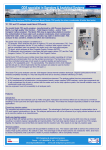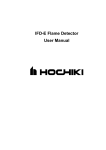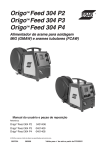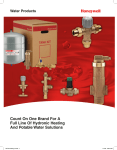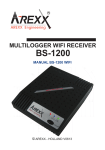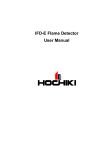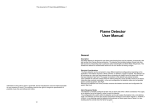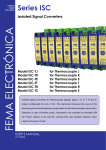Download - ODS-instrumentatie NL
Transcript
Online TC, TOC, TN, COD, TOD-analyser model Quickultra The online Quickultra, manufactured by LAR Process Analysers AG, is a multi functional TC, TOC, COD, TN analyser. This analyser is designed and suitable for use in an industrial area. Common applications are the monitoring of process water, waste water, cooling water, influent and effluent streams. The Quickultra uses a patented injection system. A precise volume of waste water is injected into the thermal oxidation reactor. At a temperature of 1200ºC all species e.g. inorganic carbons, organic carbons and organic nitrogen components are fully oxidised (100% recovery). No catalyst is used. The Quickultra is available as a: Total Carbon Analyser (TC-analyser) Total Organic Carbon analyser via the direct method (TOC-direct) Total Organic Carbon analyser via the differential method (TOC-differential). Total Nitrogen analyser (TN) Total Oxygen Demand analyser (TOD); synonym with fast Chemical Oxygen Demand (COD-o) In principle any combination of above mentioned analysis methods is available! TC/TOC, TN and TOD are measured simultaneously meaning that the measurement results are directly available after one analysis cycle, typically 3 to 5,5 minutes. The Quickultra operates via a fully programmable robot that controls the functions and positions of the robust injection needle. Only a few parts are in contact with the waste water: sample inlet tube, sample overflow vessel, sample outlet tube and an optional sample pump. After every waste water injection, the injection needle is flushed with rinse water. This all results in a minimum of maintenance. The injection volume is fully programmable from 10 to 600 micro litre making the analyser very suitable for many applications from 0,1 to 50.000 mg/litre carbon and up to 150.000 mg/litre oxygen demand. No sample dilution technique is needed. For relatively clean water, such as cooling water and effluent water, a high sample volume is injected or/and a more sensitive CO2sensor is used. For highly polluted water, such as process water and influent water, a low sample volume is injected and/or a less sensitive NDIR sensor is used. The peak area calculation method that is used, results in an excellent repeatability and long term stability. Furthermore, the advantage of using the 1200ºC thermal oxidation technique is: • no memory effects, • a rapid response to big concentration changes • A fast analysis cycle time • carry over effects (cross contamination) are very low, meaning that this analyser is very suitable for multi-stream and multi range applications. ODS delivered many Quick-analysers to all kinds of industries. We have experience with e.g. influent waste water of a pulp & paper mill, waste water of a milk powder factory, oil in water of a refinery, spill detection of petrochemical industries, waste water with waxes, brackish salty cooling water, discharge load monitoring and influent/effluent control of a WWTP. This QuickultraTC/TOC/COD/TOD/TN analyser measures quickly and accurately. Proven technology: XY-robot and 1 to 6 sample vessels Injection system, injection needle and injection port The XY-robot, in combination with the free programmable multi task software, offers unique flexibility. Furthermore the hardware is designed and pre-constructed in such a way that it is easy to change an analyser functionality or measuring principle. Examples of standard functionality: Flush the sample system during service or set-up Measure a single point of a standard or a grab sample. Evaluate the repeatability and mark outliers. • Automatically analyse samples, flush the sample system with water, flush the rest of the water to drain. • Perform a calibration routine manually or automatically • • 100% recovery with thermal oxidation at 1200ºC Online TC, TOC, TN, COD, TOD-analyser model Quickultra True TOC The Quickultra is capable of handling waste water with a high load of suspended organic particles. Not only can it easily process these samples, it also completely oxidises all organics, dissolved and organic particles. The advanced robot driven injection technique, in combination with a non catalytic 1200ºC thermal oxidation, make this possible. The QuickTOCultra measures the sum of dissolved organic carbons, particulate organic carbons and purgeable organic carbons. Features of the Quickultra Large touch screen. • Intuitive software design. Customisable configuration based on prepositional icons • Three user levels, pass word protected • The thermal oxidation technique at 1200ºC guarantees complete oxidation (100% recovery). • Also organic particles (particulate organic carbon) will be oxidised completely. • At 1200ºC memory effects are minimum resulting in a fast analyser response. • Fast analysis time of 3 minutes (TC) and 5,5 minutes (TOC) • Very stable analysing results due to the batch injection technique, auto zero technique and peak area calculation. Zero drift = 0 mg/litre C. per year. • Programmable injection volume offers flexibility in optimising and setting the analyser range. • Low salt built-up in the reactor due to the low volume injection method & 1200 degree oxidation. • Free programmable robot technique offers configuration flexibility such as very low carry over effects making the analyser suitable for 2-stream analysis, multi-stream and multi range applications. • Multi-stream feature support up to 6 streams. • Low maintenance because of a patented flush system that cleans the injection system (needle) after every sample injection. • Sample inlet filtration or conditioning is normally not needed. • Low consumption of a concentrated acid solution (only TOC-analyser uses acid) • Easy manual or automatic/daily calibration and easy validation due to internal robot selectable calibration vessel. • Easy analyser inspection due to self diagnostic software and extra diagnostic sensors such as carrier gas inlet & outlet flow measurement, relative humidity sensor (option), circuit pressure measurement. • Data presentation and data storage. internal memory and data logger. USB and RS-232 interface. • Cabinet with a separate dry compartment for all electrical parts and a wet compartment for all analyses parts. Easy access for analyser maintenance. • Optional TCP/IP and/or RS232 communication • De Quickultra ATEX Zone 2/1 Ex p cabinet with air-air cooler Touch screen with pictograms, multi language (example: Dutch) Sample pre treatment e.g. filtration is not needed (TRUE-TOC) Online TC, TOC, TN, COD, TOD-analyser model Quickultra TC, TOC, TIC ANALYSIS METHODS Block diagram of the TC-method Block diagram of the TOC-direct method Block diagram of the TOC-differential method Total Carbon: Total Organic Carbon; direct: Total Organic Carbon; differential: Dry and CO2-free carrier gas flows through the high temperature reaction tube (1200°C). Then the carrier gas flows through a gas/sample cooler and a gas scrubber The dry and clean carrier gas then flows through the NDIR CO2analyser. Prior to injection the NDIR measures the base line zero value. The TOC-concentration is determined by pretreatment of the sample via acid, prior to injection of the sample into the thermal oxidation reaction tube. The TOC concentration is determined via two different analysing steps. Step 1: The Total Carbon content (TC) of the sample is analysed. (same as TC). Step 2: Then the Total Inorganic Carbon (TIC) content is analysed The Total Organic Carbon content is then calculated via TOC = TC-TIC The robot controls the needle position and sample suction syringe. The needle is positioned into the sample overflow cup and is filled precisely with a programmed fresh sample volume. Then the robot positions the needle into the injection inlet port. A needle sensor detects the needle and opens the inlet cock valve. Then the needle is positioned deep into the 1200ºC reactor tube and a precise volume of sample is injected. Organic carbon and inorganic carbon is completely oxidized to CO2 (and H2O and NOx etc.). No catalyst is used. The carrier gas transports the CO2 to the NDIR CO2 gas analyser. Via peak area calculation the amount of CO2 is determined. By comparing the outcome to wet calibrations, the Total Carbon concentration in the waste water is calculated. The Carbonate Removal System: The sample is mixed with a strong acid solution (for example 1% of HCl). The pH of the mixture is < 2,5. This acidified sample flows into a mixing vessel and during a specific period CO2-free carrier gas bubbles through. At a pH < 2,5 Inorganic Carbon (Carbonates) react as follows: CO32- (aq) + 2H+ (aq) = H2O (aq) + CO2 (g) The carbonates, bicarbonates and free CO2 are stripped out of the sample as CO2-gas. Next the sample is drawn into the injection needle and injected into the high temperature reaction tube. All exactly as with the TC-method (described left). The outcome is presented and stored as the TOC-concentration. The TOC-direct method is also known as the Non Purgable Organic Carbon method (NPOC). It is less suitable for samples with organics that are Purgable or volatile because they can be partially stripped out during the carbonate removal step. Analysing total inorganic carbon (TIC): An extra TIC-reaction vessel is used. Via a peristaltic pump a 1% (w/w) phosphoric acid (H3PO4) solution is pumped into this TIC-vessel. Via an overflow the solution level is kept constant. CO2 free carrier gas bubbles through the acid solution. Then this carrier gas leaves the TIC-vessel and flows to the NDIR gas analyser. The CO2baseline is measured and stored. Now the robot positions the injection needle into the sample overflow vessel and draws an exact volume of sample. The needle is moved and positioned into the TIC-vessel and this sample is injected into the acid solution. Inorganic carbon reacts with the acid (pH < 2,5) to CO2 gas. The stripping gas, bubbling through the TIC-vessel, then transports the CO2 gas to the NDIR-analyser, where the CO2-peak is measured and the TOC-concentration is calculated. The TOC-differential method presents TC, TIC and TOC data. Online TC, TOC, TN, COD, TOD-analyser model Quickultra COD by correlation & COD by Total Oxygen Demand & TN ANALYSIS METHODS Block diagram of the COD-i-method Block diagram of the COD-o / TOD method Block diagram of the TNb method Chemical Oxygen Demand by COD/TOC correlation (COD-i): Fast Chemical Oxygen Demand via the TOD method (COD-o): Total Nitrogen Bounded: The COD-i measurement takes place in only 3 minutes. The measurement method is exactly the same as the TOCdirect method, so it actually is a carbon counting method. The conventional laboratory Chemical Oxygen Demand method determines the oxygen that is needed to oxidise organic species in waste water. This method takes about 2 hours per measurement. Harmful chemicals are consumed. As a consequence this CODdichromate method is not suitable for online process monitoring. However in many cases a useful and reproducible COD/TOC correlation factor can be found. In those cases the COD value is determined by the multiplication of the measured TOC value times the COD/TOC correlation factor. A nitrogen carrier gas flows through a temperature controlled permeation box where a known constant amount of oxygen permeates the nitrogen/gas flow. This nitrogen oxygen mixture flows through the high temperature reactor (1200°C). Then the carrier gas flows through a gas/sample cooler and a gas scrubber. The dry and clean carrier gas then flows through the O2-sensor. Prior to injection the O2-sensor measures the O2-value of the base line. The robot controls the needle position and sample suction syringe. The needle is positioned into the sample overflow vessel and is filled with a precisely programmed volume of fresh sample . Then the robot positions the needle into the injection inlet port and is positioned deep into the 1200°C reactor tube. A precise volume of sample is injected. The sample is quantitatively oxidized. The oxygen depletion is measured, it correlates directly to the oxygen demand of the sample. The method includes the oxygen demand by noncarbonaceous compounds. Dry and clean carrier gas flows through the high temperature reaction tube (1200°C) after which it flows through a gas/sample cooler and a gas scrubber. The dry and clean carrier gas then flows through the electrochemical NO sensor. Prior to injection this NO sensor measures the base line zero value. Examples of correlation factors are: Pulp & paper mill 2,6 Milk (whole) 3,0 Cream (40%) 3,4 Whey 2,7 Saturated fatty acids 3,3— 3,8 In those cases where multiple facilities discharge waste water to the same sewer system and/or the sample composition is widely variable, a reproducible COD/TOC-correlation factor will be hard to find. In those cases we recommend the use of the TOD-method (COD-o). (n1) (CxHyNz) + (n2) O2 -> H2O + (n5) NO + rest (n3) CO2 + (n4) Via peak area calculation the amount of O2-depletion is determined. By comparing the outcome to wet calibrations, the Total Oxygen Demand concentration in the waste water is calculated. The robot controls the needle position and sample suction syringe. The needle is positioned into the sample overflow vessel and is filled with a precisely programmed volume of fresh sample . Then the robot positions the needle into the injection inlet port and is positioned deep into the 1200ºC reactor tube where a precise volume of sample is injected. Nitrogen compounds e.g. organic nitrogen, ammonium, ammonium nitrogen, nitrate, nitrite, particulate nitrogen are oxidized to nitric oxide (NO). The carrier gas transfers the NO gas to the electrochemical NO sensor. Via peak area calculation the amount of NO gas is determined. By comparing the outcome to wet calibrations, the Total Nitrogen concentration in the waste water is calculated. Online TC, TOC, TN, COD, TOD-analyser model Quickultra Innovative Technique based on Proven Technology The Quickultra uses the identical proven technology as used in the previous Quick-series. The parts being used e.g. XYrobot, syringe, oven, reactor, seals, glass work are identical and fully exchangeable with parts of the previous Quick-series. Its technique is based on new electronics, a different operating system and bus-communication. Unlimited • • • • • • • • • Lowest detectable level 0,01 mg/l C Highest range up to 50.000 (TOC) and 150.000 ppm (TOD) without using any sample dilution No use of an expensive Pt catalyst Suitable for a variety of waste waters Up to 6 sample streams Up to 4 gas sensors. Suitable for simultaneously analysis of TC, TOC, TIC, COD-i/TOD and TNb Fast response; typical cycle time 3 to 5,5 minutes High salt option up to 30 g/l Cabinets: standard, NEMA4X, NEMA4X-high-temp, ATEX Zone 2, ATEX Zone 1 True TOC • • • • • Low maintenance Direct analysis of raw waste water. No sample filtration needed True TOC = soluble organics + purgeable organics + particulate organics At 1200ºC also organic particles are fully oxidized, 100% recovery Analysis including purgeable organic carbons and volatile organic carbons via the TOC-differential method Suitable for 2-stage fluids: dissolved oil and free oil, dissolved organics and organic particles • • • • • • • Reliable • • • • Proved technology even for the most demanding application High availability, it uses only a few wearing parts that can be replaced in minutes A set of sensors and smart diagnostic software monitor the correct functionality of the analyser High availability, suitable for process control Only a few wetted parts; sample vessel, sample tubes and injection needle. Low injection volume The injection needles is flushed with water after every sample injection No consumption of chemicals (TC, TN and TOD); only TOC requires an acid solution No use of an expensive catalyst, thermal oxidation at 1200ºC Fast replacement of only a few consumables on a monthly basis Preventative service is required once per 6 month only Accurate • • • • • • Accurate analysis results at high dynamic ranges Outstanding performance No zero drift due to the batch injection and auto zero technique Stable and repeatable measuring results due to peak area calculation Repeatable sample injection volume, full oxidation, stable and controlled carrier gas flow, stable smart gas sensors Auto or manual calibration and validation features Online TC, TOC, TN, COD, TOD-analyser model Quickultra MULTI SUM-PARAMETERS: The Quickultra analyser can be equipped with 1 to 4 gas sensors. Simultaneously the following parameters are measured: • Total Carbon (TC), Total Inorganic Carbon (TIC), Total Organic Carbon (TOC), Purgeable Organic Carbon (POC) or Volatile Organic Carbon (VOC); • True-TOC; The sum of Dissolved Organic Carbon + Suspended Organic Carbon (SOC) + Purgeable Organic Carbons • Total Nitrogen (TN / TNb); • Chemical Oxygen Demand by multiplying the TOC-value with a COD/TOC-correlation factor; • Total Oxygen Demand (TOD). Stream 1: TOC Stream 1: TC Stream 1: TC Stream 1: COD Stream 1: TIC Stream 2: TC Stream 1: COD Stream 2: COD Stream 3: TN Stream 1: COD Stream 1: TOC Stream 2: COD Stream 1: TNb Analysis method and the types of gas sensors being used Measurement of the amount of carbon dioxide gas (CO2) with a non-dispersive infrared gas sensor (NDIR) TC; Total Carbon (*) Determination of the Total carbon amount. Determination of total carbon content by Thermal combustion and analysis of the resulting CO2 The sum-measurement of total organic carbon and total inorganic carbon (TC=TOC+TIC) TIC; Total Inorganic Carbon (**) Determination of inorganic carbon (carbonates en bicarbonates). The sample is injected in a TIC-reactor. The inorganic carbon reacts with acid to CO2-gas. A carrier gas transfers the CO2gas to the CO2– sensor. The measured amount of CO2 gas is linear proportional to the amount of inorganic carbon in water NPOC / TOCdirect; Total Organic Carbon Determination of Total Organic carbon. Some purgeable organic carbons can stripped out in the carbonate removal system The sample is mixed with acid to pH < 2. Inorganic carbon reacts to carbon dioxide gas which is stripped out by use of a carrier gas The stripped sample, containing only TOC, is injected in the 1200ºC reactor. The measured amount of CO2 gas is linear proportional to the TOC-concentration TOC-differential; Total Organic Carbon Determination of Total Carbon and Total Inorganic Carbon and the calculation of Total Organic Carbon TC is determined as described at (*) The TOC-concentration is calculated by The TIC is determined as described at (**) difference. TOC = TC - TIC TOC included POC/VOC POC (VOC); Purgeable Organic Carbon Determination of Purgeable Organic Carbon (VOC) by use of a stripping technique CO2-free carrier gas bubbles through a vessel with sample. Purgeable organics are purged out Determination of the purgeable organic carbons by use of thermal oxidation and the measurement of the amount of CO2 Measurement of the amount of nitrogen oxide (NO) with an electrochemical gas sensor (ECD) TN / TNb; Total Determination of the total nitrogen Nitrogen (bounded) content by thermal oxidation and the analysis of resulting nitric oxide. The TNb content is measured via thermal The measured nitric oxide amount is linear oxidation at 1200ºC. TN measures the proportional to the Total Nitrogen sum of organic bound nitrogen (CxHyNz), concentration in water + (free) ammonia (NH3 / NH4 ), nitrite (NO2 ) nitrate (NO3-) and nitrogen bounded particles Measurement of the amount of oxygen depletion (-O2) with a zirconium oxide sensor (ZrO2) COD-o; Chemical Oxygen Demand Determination of the oxygen depletion The sample is oxidised at 1200ºC. The via the Total Oxygen Demand method. oxygen depletion is measured in the carrier gas. All compounds that consume oxygen due to the oxidation process are measured e.g. organic hydrocarbons, ammonia and organic bound nitrogen Online TC, TOC, TN, COD, TOD-analyser model Quickultra YOU NAME IT … WE BUILD IT TC-analyser 1 stream TOC-direct analyser 1 stream TC, TIC & TOC-analyser differential 2 streams TC & TN & TOD-analyser 2 streams TOC & TN 3 streams TC, TIC, TOC-analyser differential 6 streams MULTI STREAM: The Quickultra-analyser is suitable for the sequential analysis of 1 to 6 sample streams. This analysis uses a series of quartz glass vessels which are possitioned and mounted in a row. The following vessel types are used: 1 to 6 sample overflow vessels, 1 or 2 calibration vessels and a waste vessel. Its configuration depends on the specific application e.g. how many sample streams, the ranges to be analysed and the analytical method(s). These vessels are lined up with the injection port of the 1200ºC reactor and, if needed, the TIC-reactor. A robust XY-robot works in cooperation with an advanced injection system and a thick injection needle. This needle is positioned above the row of quartz glass vessels and/or reactor(s). The great advantage of the use of the XY-robot and injection system is that a minimum of wetted parts are needed. In this system no moving parts e.g. pinch valves, solenoid valves and rotating valves are used. Its an excellent system for multi stream applications, cross over contamination and carry over effects are eliminated. MULTI INJECTION VOLUME The Quickultra offers the capability to enter program parameters per sample stream. An important parameter to enter is the sample injection volume. The great advantage is that sample streams with relative big differences in concentration levels can be measured accurately with one gas detector. For example: The influent TOC-level of a waste water treatment plant varies from 100 to 1000 mg/l C. The effluent TOC-level of the treated waste water varies from 10 to 100 mg/l C. Influent and effluent water is measured with one QuickTOCultra with only one NDIR-detector. It is configured in such a way that the injection volume of the influent measurement is 30 μl and for the effluent measurement is 300 μl. All TOC-values in the range of 10 to 1000 mg/l C are measured accurate. MULTI RANGE: The Quickultra multi range option is very suitable for applications where an extended rangeability is needed e.g. a TOC-range from 10 to 50.000 mg C/l . To guaranty that the analyser also measures accurately at low levels, it is equipped with two gas sensors working in parallel. The NDIR gas sensor with a long gas cell measures accurate in the low TOC range, the NDIR with the short gas cell, is most suitable for precise measurements in the high range. Online TC, TOC, TN, COD, TOD-analyser model Quickultra LAR’s Range of Online Water Quality Analysers LAR’s range of water quality analysers Chemical Oxygen Demand analyser - model ELOX-100 • This COD method is based on Electrochemical oxidation BOD and Respiration Analyser - Model BioMonitor • Online fast and quick respiration measurement of the biological oxygen consumption • Determination of the self respiration of the activated sludge Toxicity analyser - Model Nitritox & Toxalarm • Measurement parameters: • BOC - Biological Oxygen Consumption with Correlation to BOD5 laboratory method • ASR – Activated Sludge Respiration Projects ODS has the know-how and experience to offer complete customized analyser projects. We offer turn key projects: Materials: • A walk-in shelter • Analysers TC, TOC, TOD, COD, OIW (oil in water) etc, • Power distribution; power sockets, lighting • Junction boxes; signal distribution • Fluid piping e.g. a drain header • HVAC; coolers, heater, dehumidifier • Utilities such as instrument air piping, a zero air supply or nitrogen generator • Extras such as a reagent cabinet, arctic boxes • Waste water pumps • Fast sample loop • Samplers e.g. anti-isokinetic sampler • Spare part kits TC/TOC-analyser by UV-persulphate - Model Quick-TOC-UV • Its measuring principle is based on photochemical oxidation Services: with use of persulphate oxidising agent and OH-radicals • Application research, sample tests produced by UV-light • Recommendation reports • Engineering • Documentation package, drawings and manuals, FATTC/TOC/TIC/VOC pure water analysers document, SAT-document, system CE-certification, risk • Single and multi-stream analysers for return condensate analyses etc, and boiler feed water applications • In-House test • Factory Acceptance Test TC/TOC/TN/TP/COD-i; model QuickTOCNPO • Shipment, packaging, crates, insurance • Installation and commissioning & start-up on-site • Total Organic Carbon and Total Nitrogen by thermal • A Site Acceptance Test oxidation at 1200°C, multi loop injection and simultaneous • Training: Measurement principles and hands-on opeation analysis of TOC/TN • After sales service • Total Phosphorous • Service contracts Measuring principle: molybdenum blue method Oxidation by UV+persulphate to PO43- According to DIN ISO 6878 Online TC, TOC, TN, COD, TOD-analyser model Quickultra Quickultra-analysers in end test and almost ready for shipment The injection needle positioned in the injection port of the reactor Training at LAR Process Analysers AG Berlin The Quickultra is equipped with a 10.4 inch touch screen ODS engineer check of the pH of a QuickTOCultra analyser Two sample vessels, two calibration vessels and one waste vessel Flexibility, multi tasking and easy control via icon driven menus Quickultra, measurement of TC, COD and TN all in 3 minutes only ODS project with a walk in shelter and a QuickTOC Acid and demin water are safely stored in a reagent cabinet Control of a skimmer via a 2-stream QuickTOCultra A QuickTOC in an ODS analyser shelter True-TOC includes the measurement of particulate organic carbon Oily waste water is pumped into a fast sample loop Anti-isokinetic flow samplers separate big particles from the sample ODS engineers installed another online TOC-analyser system Online TC, TOC, TN, COD, TOD-analyser model Quickultra Online process TC, TOC, TN, COD, TOD analyser model Quickultra General specification Type Manufacturer Analytical Method Use Typical applications Sample requirements • Pressure • Flow; no internal sample pump • Flow; with internal sample pump • Temperature, maximum • Size Organic Particles • Salt; as NaCl (gram/litre) Sample conditioning: • Filtration • Fast sample loop • Anti-Isokinetic flow sampler Connections: • Sample • Carrier gas • Exhaust / carrier gas • Fluids to the drain header Power; • Voltage / Frequency (V, Hz) • Power consumption Rinse water Certificate Electrical cables Signals: • Analogue outputs • Relays / alarms Materials; wetted parts (sample) • Inlet tube • Overflow vessel • Drain tube • Injection needle • Reactor • Sample pump (TOC) Mounting: • Basis • Rack / Frame • Hardware Extra diagnostic sensors: • Thermal Mass Flow, carrier gas inlet • Thermal mass Flow; carrier gas outlet • Pressure sensor; reactor pressure and pressure pulse • Relative Humidity sensor; after condensate cooler USB connection (download/upload) Service menu: • Service • Calibrate • Status; tests • Test run • Setting of alarm parameters • Observe measured values of sensors Model Quickultra LAR Process Analysers AG, Germany, Berlin TC, TOC-direct, TOC-differential, COD-i by COD/TOC-correlation, TN, TOD / fast COD-o via thermal combustion of the sample at 1200ºC and the analyses of the formed carbon dioxide, nitric oxide or measurement of the oxygen depletion Stationary Online Influent & effluent of a WWTP, storm water monitoring, cooling water, spill detection, load monitoring, process water monitoring and control etc. • • • • • • Atmospheric to a slight overpressure; 0,05 to 0,2 bar 50 to 200 ml/min to internal sample overflow vessel 30 ml/m; pre-pump time is selectable 60ºC Typical up to 1 mm (most particles are soft and spongy saturated with water) Up to 15 gram/litre; Up to 60 gram/litre by use of high salt option • No, not needed • Yes, recommended velocity of sample flow >1 m/s • Yes, we recommend using the anti-isokinetic sampling technique to separate big particles with high mass (consult ODS BV for details) • • • • 6/4 mm (OD/ID) / one per stream 6/4 mm (OD/ID) / instrument air (nitrogen for COD-o/TOD) 6/4 mm (OD/ID) 10/8 mm (OD/ID) PVC tubes / to be connected into a drain header / slope down • 230 / 50; (optional 110 / 60) • 950 VAaverage only during start-up, 600 VA typical 1 or 2 litre/week; depends on cycle time CE Via Glands; top of cabinet • 4-20 mA; isolated, active, max 500 ohm; free programmable (1 per stream) • 4 each; contact closure; free programmable; fail safe • • • • • • Nylon Quartz Glass PVC Stainless steel 316 Ceramic Marprene® • Wall / solid, perfectly flat and horizontal, for example a concrete wall • Metal Frame, steel, coated, free standing (option: free standing LAR frame) • 4 expender bolts; M8 (part of the delivery) Measures status of: • Carrier gas consumption, differential inlet/outlet carrier gas • Leakage in the gas circuit; flowchecks sample injection via flow variations • Blocking of the reactor output or gas circuit; • Checks good operation of cooler, protects and bypasses gas sensors if needed • Program parameter settings • Data transfer of log-files • Screen shots • User level control • • • • • • Flush injection system or sample lines, Furnace on/off, Condensate pump on/off.. Manually validation or calibration, daily automatic calibration Relays, signal outputs, oven, cooler etc. Check settings and fine-tune robot positions. Pressure, delta P, carrier gas flow balancing and limits, R.H. limits etc. Gas sensor signal, graphical curve, carrier gas inlet and outlet etc. Online TC, TOC, TN, COD, TOD-analyser model Quickultra General Specification, continued Display Menu Data logging Warranty Documentation Maintenance and routine service: • Calibration • Cleaning of sample system • Inject-port • Outlet reactor • Pump tubes, condensate pump and sample pump • Scrubbers (aerosol / brass & zinc) Multi stream Reactor High Salt version Languages: labels and soft keyboard • Standard • Special RS232 and TCP/IP communication ports Analyser frame, rack Reagent cabinet Zero air supply: • Passive • active Nitrogen generator Sample delivery pump: • Submersible • Peristaltic Anti-isokinetic sampler • Material • Size • Arctic box 10,4 inch TFT colour touch screen Intuitive software design Configuration by use of pictograms Multi language: standard English, German (contact your local LAR representative). 3 user levels; accessible by passwords Input via soft keyboard and soft numeric keyboard Modes: Information, visualising tables and graphs and peaks, calibration & validation, measurement parameters, service issues, data logger, etc. Logger capacity for years of data Measuring values TC, TOC, TN, COD etc. Calibration data Log book of events Format: csv (text) 1 year after delivery; wearing parts and consumables excluded • Manuals, drawings, spare part listing • User manual available in the English language; • Drawings, schematics included. • Technical training manuals on request • • • • • • As needed e.g. 1x per month. This analyse is very stable! 1x per month / clean applications: 1x per 2 month 1x per month / o-ring replacement Depends on salt content and injection volume; 1x per 6 month; 1x per month 4x per year; replace 4x per year; replace content (depends on sample composition) Options Up to 6 sample stream; includes software upgrade, sample vessels, sample pumps, sample tubes. Sample and hold technique. Output values are frozen till they are refreshed Special reactor capable of handling brackish and salty waste water. Note: Salt is removed easily by shaking it out of the well accessible reactor foot • English, German, Korean, Chinese (to be specified) • Any language and character set (to be specified) • Communication via e.g. remote control Additional equipment • Stable frame for the Quickultra and reagent cabinet. Steel, coated. • For storage of 2 each 5 litre tanks e.g. demin water and a 1% w/w acid solution • Cartridges with activated carbon and soda lime. To be refilled every month. • Pressure Swing Absorption; maintenance once per 2 years. Outlet CO2 <1 ppm • Pressure Swing Absorption; maintenance once per 2 years. Outlet O2 <10 ppm • Type and model depends on application e.g. 400 VAC 3-phase; 1 1/2 “ • Type and model depends on application e.g. 1”, 230 VAC, speed control • Several option e.g. PVC, PE or SS • Several option e.g. 1/2”, 1” • Insulated, reinforced fibreglass box. Space for 1 or 2 samplers Online TC, TOC, TN, COD, TOD-analyser model Quickultra Quickultra Analytical Methods & Gas Sensors Carbonaceous species Analytical Method Conform Ranges Repeatability Reproducibility Drift Cycle time Type of detector Carrier gas requirements: • Quality • Consumption • Pressure Acid solution; strength and consumption Outputs 4-20 mA / data logging Nitrogen species Analytical Method Conform Ranges Repeatability Reproducibility Drift Cycle time Type of detector Carrier gas requirements: • Quality • Consumption • Pressure Reagents, acid Outputs 4-20 mA / data logging Oxygen demand methods Analytical Method Conform Ranges Repeatability Reproducibility Drift Cycle time Type of detector Carrier gas requirements: • Quality • Consumption • Pressure Reagents Outputs 4-20 mA / data logging TC, TOC-direct, TOC-differential (TRUE-TOC), TIC Determination of the organic carbon content via thermal combustion of the sample at 1200ºC and the analyses of the resulting carbon dioxide DIN EN 1484, ISO 8254 en EPA 415.1 0 to 10 up to 0 to 50000 mg/l C (to be specified) Typical <2% CV (of measured value, 25 to 100% of scale) Typical <1% CV 0 mg/l C per year; auto zero technique TC: 3 minutes (programmable) TOC: 5,5 minutes (programmable) NDIR infrared, no moving parts; maintenance free; digital data transfer; with integrated pressure and temperature compensation • Dry and free of CO2 ,particles and hydrocarbons • TC: Typical 30 Nl/h, TOC-direct: 45 Nl/h (multi stream add 8 Nl/h per sample stream 2 to 6) • 1,5 to 6 barg • TC; no acid needed. • TOC-direct; 1% w/w/ hydrochloric acid; 2 litres/week (or less when cycle time is longer) • TOC-differential; 1% w/w phosphoric acid; 2,5 litres/week (or less when cycle time is longer) • TC-analyser: TC one output per stream • TOC-direct; TOC (NPOC); one output per stream • TOC-differential; TC, TOC and TIC; amount of outputs to be specified! TN Determination of the total nitrogen content by thermal combustion at 1.200ºC and the analysis of the resulting NO-gas DIN 38469 part 27, EN 12260, ISO-TR11905-2. 50, 200, 1000 mg/l N (to be specified) Typical <3% CV (of measured value, 25 to 100% of scale) Typical <2% CV 0 mg/l N per year; auto zero technique 3 minutes (programmable) Electrochemical, solid state, to be exchanged once per 1 1/2 year • Dry and free of particles and hydrocarbons • Typical 30 Nl/h • 1,5 to 6 barg Not needed TN; one output per stream COD-o / TOD Determination of the oxygen demand via thermal combustion of the sample at 1200 degrees Celsius and the measurement of the amount of oxygen depletion in the oxygen enriched nitrogen carrier gas. ASTM D6238 - 98(2011) 500, 500, 2000, 8000, 15000, 30000 and 150000 mg/l -O2 (to be specified) Typical <3% CV (of measured value, 25 to 100% of scale) Typical <2% CV < 10 mg/litre -O2 per year due to auto zero technique 3 minutes (programmable) O2-sensor, zirconium oxide • Nitrogen, high purity (grade 5.0 / 99,999 % N2 / < 10 ppm O2 and CxHy; required grade depends on TOD-analyser range) • Typically 20, maximum 28; 1 each cylinder (50 l / 200 bar) nitrogen per week. • 1,5 to 6 barg Not needed TOD; one output per stream Online TC, TOC, TN, COD, TOD-analyser model Quickultra Quickultra Cabinet versions Standard cabinet NEMA4X cabinet ATEX Zone 2 Ex p cabinet ATEX Zone 1 Ex p cabinet Purpose Standard industrial area e.g. Industrial area with risk of an analyser shelter, corrosive vapours and building, factory gasses Hazardous area with risk of Hazardous area with risk of explosive gasses or vapours explosive gasses or vapours according ATEX zone 2 according ATEX zone 1 IP classification IP54 IP64 IP64 Ex II 3 G Ex pz II T3 Ex II 2 G Ex px II T3 Hazardous area according IP64 - - Ambient air temperature • recommended • Minimum / maximum • 5 to 30ºC • 0 to 38ºC • 5 to 25ºC • 0 to 30ºC • 5 to 25ºC • 0 to 30ºC • 5 to 25ºC • 0 to 30ºC Ambient air humidity Max. 95% (non condensing) Max. 95% (non condensing) Max. 95% (non condensing) Max. 95% (non condensing) Cooling / heat transfer by ambient air and a fan Integrated advanced air-air heat exchanger Integrated advanced air-air heat exchanger Integrated advanced air-air heat exchanger Material of the cabinet Steel, coated grey, hinges/ right side, window Securit Stainless Steel 316; brushed, coated / transparent hinges / right side, window Securit Stainless Steel 316, brushed, coated / transparent hinges / right side, window Securit Stainless Steel 316, brushed, coated / transparent hinges / right side, window Securit (hxwxd) (hxwxd) (hxwxd) • 1060x815x570 mm • 1060x935x570 mm • 1060x912x570 mm • 1060x992x570 mm • 1060x915x570 mm • 1060x995x570 mm Request for a detailed drawing Request for a detailed drawing Request for a detailed drawing Request for a detailed drawing 105 kg 120 kg 120 kg 120 kg Dimensions: (hxwxd) Excl. glands, connectors etc • 1060x595x530 mm • 1-stream • 2-6 streams (incl. pumps) • 1060x750x530 mm Weight (1-stream) OPTIONS High temperature version Ambient air 5 to 50ºC Zero Air Supply • Passive by cartridges • Active by PSA Passive or Active • Yes • Yes, recommended via an integrated compressor cooler • Yes • Yes, recommended - • Yes, recommended • Special via Ex d - • Yes, recommended • Option: Special via Ex d Hardware / analyser cabinet The Quickultra is built in a rugged steel/stainless steel cabinet. The analyser is suitable for wall, frame or strut mounting. It has two separate compartments. Both compartments are easy accessible for maintenance. The analyser compartment have the following features: • Dry compartments for the electrical distribution units, power supplies, electronics, e.g. I/O-nodes, gas sensors and the panel computer with big touch screen display; • Wet compartment for the XY-robot, sample vessels, sample stirrers, injection system, electrical oven with reactor tube, peristaltic pump, peltier cooler etc. Due to modifications or improvements specifications are subject to change by manufacturer or ODS without notice revision: 2012-07













